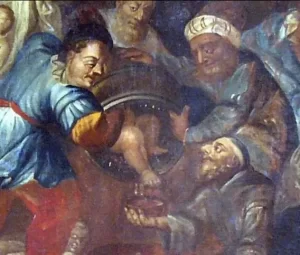Jewish Ritual Murder, 17th-19th Centuries
April 5, 2025

“1603. Verona. A jew was tried on a charge of killing a child to get its blood for an infamous purpose. He was acquitted.
“1670. Metz. As this was a very strongly established case, one does not find any mention of it in Strack’s book in defence of the jews! A three-year-old boy was lost by his mother on the way to a well. The boy was wearing a red cap, and witnesses had seen him carried away by a jew mounted on a horse. This jew was Raphael Levi. At first, the boy’s body could not be traced. The jews, becoming frightened, spread the report that wolves must have killed him in the forest.
“The forest was searched and eventually the head, neck and ribs of a boy were found, together with clothes which were identified as the missing boy’s, red cap and all, by the boy’s father. But as these clothes were neither torn nor bloody, it was concluded that the wolf story was a “blind,” and then witnesses came forward who had seen Raphael Levi with the boy in such places and at such times as to remove all doubt of his guilt. Levi was sentenced to death by the order of the Parliament of Metz, and was burned alive.
_____________
“1748. Duniagrod, Poland. jews condemned for Ritual Murder by Episcopal Court.
“1753. Pavalochi, Poland. jews condemned for Ritual Murder by Episcopal Court.
“1753. Zhytomir, Poland. In this case, a three-year-old boy was murdered; jews were tried by the Episcopal Court of Kiev and condemned to death.
“1823. Velisch, Russia. On Easter Sunday, a 21⁄2-year-old boy disappeared. His body was found in a marsh one week later; there were punctured wounds all over the body and the skin was scarified. There were wounds of circumcision; the feet were bloody and a bandage had been tied around the legs.
__________
“1831. St. Petersburg. The daughter of a non-commissioned officer was the victim in this case. There were five judges, of whom four recognised the ritual character of the murder. The jewish murderers were transported to Siberia. Monniot says the facts of this case are not contested.
“1840. Rhodes. On the eve of Purim a small Greek boy was missed; he had been seen entering a house in the jewish quarter; after that he was never seen again.
“1840 The Damascus Case. This case, now almost completely forgotten by Democracy, convulsed Europe for a considerable time owing to the agitation induced by the jewish Money Power which left no stone unturned to misrepresent and vilify the individuals responsible for bringing the jews to justice. Fourteen jews were found guilty, and ten were condemned to death, two having died.
“1852 and 1853. Saratov. Two ritual murders are involved this time; one, a 10-year-old boy in December, 1852; the other, 11-year-old, in January, 1853. After a flood, both bodies were found on the bank of the Volga, pierced with many wounds. Eight years afterwards, two jews, Schiffermann and Zourloff, were duly tried for these murders and convicted. They were sentenced to 28 years’ labour in the mines, and they died during their imprisonment.
____________
“1880. Smyrna. Many jews were massacred after a missing child’s body had been found on the beach covered with punctured wounds at Passover.
“1882. The Tisza Eszlar Case in Hungary. The prisoners duly confessed, and after long drawn out proceedings, they were all acquitted as the result of the Organised Power of jewish Money. Esther Solymosi, 14 years old, disappeared on 1st April; the five-year-old son of the jewish sexton told some women that his mother had enticed the girl into their house, whence she had been slipped by some jews into the synagogue premises.
“1891. Xanten, Prussia. A five-year-old boy called Hegmann was murdered, his threat cut and the body bloodless. “The Government did all in its power to suppress the rumour” of ritual murder.
“1899. The Polna Case (Bohemia).
Agnes Hruza, 19 years of age, was murdered 29th March, 1899. On 1st April, her body was found in a wood with the head nearly severed from the body. In spite of this frightful wound, there was no blood about, although the body itself, of course, was almost bloodless.
“Then, another girl’s body was found, too decomposed to show the cause of death; this was the body of Maria Klima who had disappeared 17th July, 1898. Hilsner was charged with both murders when the case came on again in November. The Court found the prisoner guilty, without however alleging ritual reasons, and the prisoner was sentenced to death on 14th November, 1900. However, the Emperor intervened, and the sentence was commuted to life imprisonment. Hilsner was released from prison by the Marxists in the rioting of 1918; he died a few years later.”
